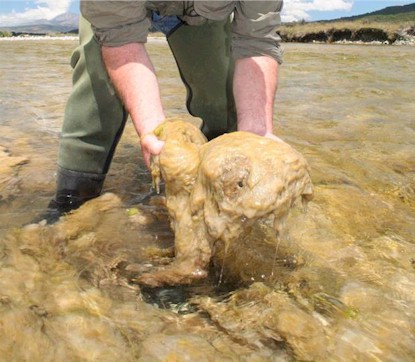Home → Monitoring & Assessment > Lakes > Invasives > Materials > Rock Snot
New Aquatic Nuisance Species Threatens Maine streams and Rivers: Didymo or "Rock Snot" 
Anglers and boaters using Maine 's streams and rivers are urged to be aware of a new threat! The aquatic nuisance alga known commonly as "Didymo" ( Didymosphenia geminata ) or "rock snot" has invaded the northern reaches of the Connecticut River in New Hampshire and in the White River and Battenkill River in Vermont. These are the first official reports of the invasive algae in the northeastern U.S.
This highly invasive species has not been detected in Maine. However, it already affects freshwater rivers and streams in other parts of the U.S., Canadian provinces of Quebec and New Brunswick and New Zealand. It is not known at this time how Didymo will affect water quality, aquatic habitat and fish populations in Maine, but its potential to alter habitats and displace natives species are of great concern to officials in regions where infestations have been established.
It is critical for anglers and boaters to be aware that Didymo is easily spread by even just one cell of the alga breaking off and drifting downstream in infested reaches. It is also very easily spread by waders, fishing gear and other gear that touches the bottoms of streams in infested areas, so it is essential to check and clean your fishing gear!
Photo: Biosecurity New Zealand
Anglers and boaters: How to clean your gear
Check : Before leaving a river or stream, remove all obvious clumps of algae and look for hidden clumps. Leave them at the affected site. If you find any later, do not wash them down drains; dispose all material in the trash.
Clean : Soak and scrub all items for at least one minute in hot (140 degrees F) water and a five percent solution (one cup per gallon of water) of dishwashing detergent. Soak felt-lined waders and other absorbent material for at least 30-40 minutes.
Dry : If cleaning is not practical, after the item is completely dry to touch, wait an additional 48 hours before contact or use in any other waterway.
These steps are more than suggestions; they're absolutely essential for preserving the quality of Maine rivers and streams.
|
How to tell if you may be seeing Didymo |
||
YES |
NO |
|
Location |
mostly clear flowing water with rocky bottom, may be attached to plants |
deep silty areas with no rocks or plants, highly colored waters. |
Color |
tan, light brown or whitish |
green or dark brown/black |
Texture |
clumps or ropy strands, rough cottony feel, fibrous |
thin layers, slippery or gelatinous |
Appearance |
no leaves or roots (BUT may attach to leaves or stems). Sometimes mistaken for fiberglass, toilet paper or tissue. |
has leaves or roots |
If your sample matches three of the yes descriptions above, you may have found Didymo. We'd like to know!
- Please send a dime-sized sample in small container or folded in a business card to: Maine DEP Invasive Species Program, State House Station 17, Augusta ME 04333. Contact us at telephone 1-800-452-1942, or email Milfoil@Maine.gov .
- Be sure to include your name, address and phone or email so that we may contact you.
- Also, please provide a detailed description of where you found your sample: name of the river or stream, the town, and precise location (such as GPS coordinates, nearest road, or a clearly marked map).